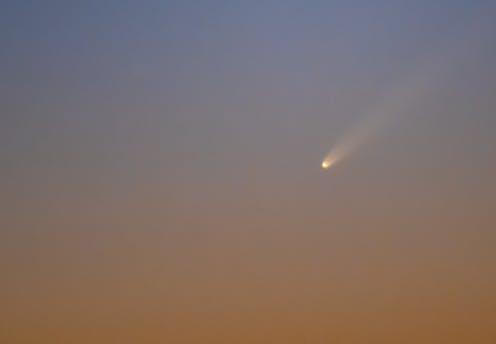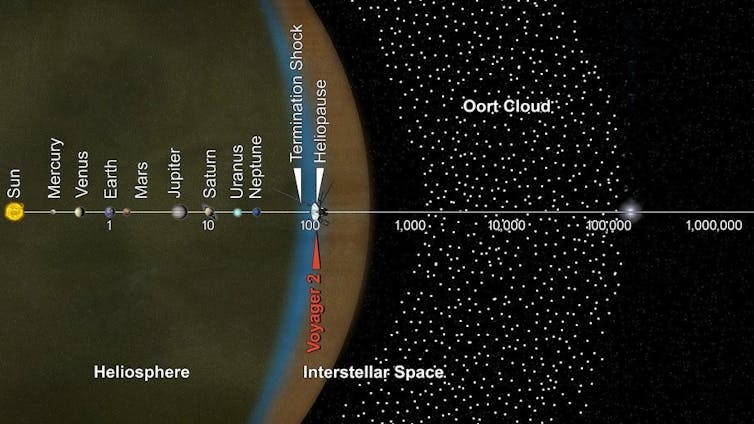Comet Tsuchinshan-ATLAS is a Halloween visitor from the spooky Oort Cloud − the invisible bubble tha
Comet Tsuchinshan-ATLAS is one of 2 comets from the Oort Cloud passing by Earth in October 2024.

The human mind may find it difficult to conceptualize: a cosmic cloud so colossal it surrounds the Sun and eight planets as it extends trillions of miles into deep space.
The spherical shell known as the Oort Cloud is, for all practical purposes, invisible. Its constituent particles are spread so thinly, and so far from the light of any star, including the Sun, that astronomers simply cannot see the cloud, even though it envelops us like a blanket.
It is also theoretical. Astronomers infer the Oort Cloud is there because it’s the only logical explanation for the arrival of a certain class of comets that sporadically visit our solar system. The cloud, it turns out, is basically a gigantic reservoir that may hold billions of icy celestial bodies.
Two of those bodies will pass by Earth in the days leading up to Halloween. Tsuchinshan-ATLAS, also known as Comet C/2023 A3, will be at its brightest, and likely visible to the naked eye, for a week or two after Oct. 12, the day it’s closest to Earth – just look to the western sky shortly after sunset. As the days pass, the comet will get fainter and move to a higher part of the sky.
The second comet, C/2024 S1 (ATLAS), just discovered on Sept. 27, should be visible around the end of October. The comet will pass closest to Earth on Oct. 24 – look low in the eastern sky just before sunrise. Then, after swinging around the Sun, the comet may reappear in the western night sky right around Halloween. It’s possible, however, that it could disintegrate, in part or in whole, as sometimes happens when comets pass by the Sun – and this one will come within 1 million miles (1.6 million kilometers) of our star.
As a planetary astronomer, I’m particularly curious about the Oort Cloud and the icy bodies inhabiting it. The Cloud’s residents may be a reason why life ignited on Earth; crashing on our planet eons ago, these ice bodies may have supplied at least some of the water that all life requires. At the same time, these same objects pose an ever-present threat to Earth’s continuation – and our survival.
Billions of comets
If an Oort Cloud object finds its way to the inner solar system, its ices vaporize. That process produces a tail of debris that becomes visible as a comet.
Some of these bodies, known as long-period comets, have orbits of hundreds, thousands or even millions of years, like Tsuchinshan-ATLAS. This is unlike the so-called short-period comets, which do not visit the Oort Cloud and have comparatively quick orbits. Halley’s comet, which cuts a path through the solar system and orbits the Sun every 76 years or so, is one of them.
The 20th-century Dutch astronomer Jan Oort, intrigued by the long-period comets, wrote a paper on them in 1950. He noted about 20 of the comets had an average distance from the Sun that was more than 10,000 astronomical units. This was astounding; just one AU is the distance of the Earth from the Sun, which is about 93 million miles. Multiply 93 million by 10,000, and you’ll find these comets come from over a trillion miles away. What’s more, Oort suggested, they were not necessarily the cloud’s outermost objects.
Nearly 75 years after Oort’s paper, astronomers still can’t directly image this part of space. But they do estimate the Oort Cloud spans up to 10 trillion miles from the Sun, which is almost halfway to Proxima Centauri, the next closest star.
The long-period comets spend most of their time at those vast distances, making only brief and rapid visits close to the Sun as they come in from all directions. Oort speculated the cloud contained 100 billion of these icy objects. That may be as numerous as the number of stars in our galaxy.
How did they get there? Oort suggested, and modern simulations have confirmed, that these icy bodies could have initially formed near Jupiter, the solar system’s largest planet. Perhaps these objects had their orbits around the Sun disturbed by Jupiter – similar to how NASA spacecraft bound for destinations from Saturn to Pluto have typically swung by the giant planet to accelerate their journeys outward.
Some of these objects would have escaped the solar system permanently, becoming interstellar objects. But others would have ended up with orbits like those of the long-period comets.

Threats to Earth
Long-period comets present a particular potential danger to Earth. Because they are so far from our Sun, their orbits are readily altered by the gravity of other stars. That means scientists have no idea when or where one will appear, until it does, suddenly. By then, it’s typically closer than Jupiter and moving rapidly, at tens of thousands of miles per hour. Indeed, the fictional comet that doomed Earth in the film “Don’t Look Up” came from the Oort Cloud.
New Oort Cloud comets are discovered all the time, a dozen or so per year in recent years. The odds of any of them colliding with Earth are extremely low. But it is possible. The recent success of NASA’s DART mission, which altered the orbit of a small asteroid, demonstrates one plausible approach to fending off these small bodies. But that mission was developed after years of studying its target. A comet from the Oort Cloud may not offer that much time – maybe just months, weeks or even days.
Or no time at all. ’Oumuamua, the odd little object that visited our solar system in 2017, was discovered not before but after its closest approach to Earth. Although ’Oumuamua is an interstellar object, and not from the Oort Cloud, the proposition still applies; one of these objects could sneak up on us, and the Earth would be defenseless.
One way to prepare for these objects is to better understand their basic properties, including their size and composition. Toward this end, my colleagues and I work to characterize new long-period comets. The largest known one, Bernardinelli–Bernstein, discovered just three years ago, is roughly 75 miles (120 kilometers) across. Most known comets are much smaller, from one to a few miles, and some smaller ones are too faint for us to see. But newer telescopes are helping. In particular, the Rubin Observatory’s decade-long Legacy Survey of Space and Time, starting up in 2025, may double the list of known Oort Cloud comets, which now stands at about 4,500.
The unpredictability of these objects makes them a challenging target for spacecraft, but the European Space Agency is preparing a mission to do just that: Comet Interceptor. With a launch planned for 2029, the probe will park in space until a suitable target from the Oort Cloud appears. Studying one of these ancient and pristine objects could offer scientists clues about the origins of the solar system.
As for the comets now in Earth’s vicinity, it’s OK to look up. Unlike the comet in the DiCaprio movie, these two will not crash into the Earth. The nearest Tsuchinshan-ATLAS will get to us is about 44 million miles (70 million kilometers); C/2024 S1 (ATLAS), about 80 million miles (130 million kilometers). Sounds like a long way, but in space, that’s a near miss.
James Wray receives funding from NASA.
Read These Next
The world risks forgetting one of humanity’s greatest triumphs as polio nears global eradication − 7
Polio may finally be defeated in the next 5 years. Will the world recognize what an extraordinary achievement…
Miami’s new mayor faces a housing affordability crisis, city charter reform and a shrinking budget
Eileen Higgins won a hard-fought election to become Miami’s new mayor. Now for the hard part – governing…
‘This year nearly broke me as a scientist’ – US researchers reflect on how 2025’s science cuts have
US science lost a great deal in 2025, including tens of billions of dollars of federal funding, entire…





